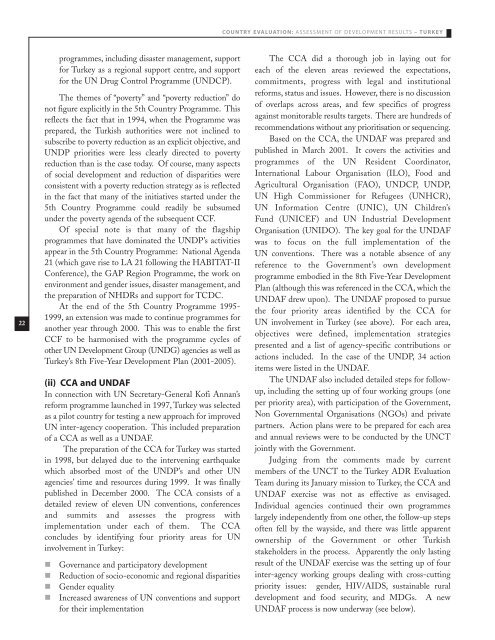Reports - United Nations Development Programme
Reports - United Nations Development Programme
Reports - United Nations Development Programme
You also want an ePaper? Increase the reach of your titles
YUMPU automatically turns print PDFs into web optimized ePapers that Google loves.
COUNTRY EVALUATION: ASSESSMENT OF DEVELOPMENT RESULTS – TURKEY<br />
22<br />
programmes, including disaster management, support<br />
for Turkey as a regional support centre, and support<br />
for the UN Drug Control <strong>Programme</strong> (UNDCP).<br />
The themes of “poverty” and “poverty reduction” do<br />
not figure explicitly in the 5th Country <strong>Programme</strong>. This<br />
reflects the fact that in 1994, when the <strong>Programme</strong> was<br />
prepared, the Turkish authorities were not inclined to<br />
subscribe to poverty reduction as an explicit objective, and<br />
UNDP priorities were less clearly directed to poverty<br />
reduction than is the case today. Of course, many aspects<br />
of social development and reduction of disparities were<br />
consistent with a poverty reduction strategy as is reflected<br />
in the fact that many of the initiatives started under the<br />
5th Country <strong>Programme</strong> could readily be subsumed<br />
under the poverty agenda of the subsequent CCF.<br />
Of special note is that many of the flagship<br />
programmes that have dominated the UNDP’s activities<br />
appear in the 5th Country <strong>Programme</strong>: National Agenda<br />
21 (which gave rise to LA 21 following the HABITAT-II<br />
Conference), the GAP Region <strong>Programme</strong>, the work on<br />
environment and gender issues, disaster management, and<br />
the preparation of NHDRs and support for TCDC.<br />
At the end of the 5th Country <strong>Programme</strong> 1995-<br />
1999, an extension was made to continue programmes for<br />
another year through 2000. This was to enable the first<br />
CCF to be harmonised with the programme cycles of<br />
other UN <strong>Development</strong> Group (UNDG) agencies as well as<br />
Turkey’s 8th Five-Year <strong>Development</strong> Plan (2001-2005).<br />
(ii) CCA and UNDAF<br />
In connection with UN Secretary-General Kofi Annan’s<br />
reform programme launched in 1997, Turkey was selected<br />
as a pilot country for testing a new approach for improved<br />
UN inter-agency cooperation. This included preparation<br />
of a CCA as well as a UNDAF.<br />
The preparation of the CCA for Turkey was started<br />
in 1998, but delayed due to the intervening earthquake<br />
which absorbed most of the UNDP’s and other UN<br />
agencies’ time and resources during 1999. It was finally<br />
published in December 2000. The CCA consists of a<br />
detailed review of eleven UN conventions, conferences<br />
and summits and assesses the progress with<br />
implementation under each of them. The CCA<br />
concludes by identifying four priority areas for UN<br />
involvement in Turkey:<br />
<br />
<br />
<br />
<br />
Governance and participatory development<br />
Reduction of socio-economic and regional disparities<br />
Gender equality<br />
Increased awareness of UN conventions and support<br />
for their implementation<br />
The CCA did a thorough job in laying out for<br />
each of the eleven areas reviewed the expectations,<br />
commitments, progress with legal and institutional<br />
reforms, status and issues. However, there is no discussion<br />
of overlaps across areas, and few specifics of progress<br />
against monitorable results targets. There are hundreds of<br />
recommendations without any prioritisation or sequencing.<br />
Based on the CCA, the UNDAF was prepared and<br />
published in March 2001. It covers the activities and<br />
programmes of the UN Resident Coordinator,<br />
International Labour Organisation (ILO), Food and<br />
Agricultural Organisation (FAO), UNDCP, UNDP,<br />
UN High Commissioner for Refugees (UNHCR),<br />
UN Information Centre (UNIC), UN Children’s<br />
Fund (UNICEF) and UN Industrial <strong>Development</strong><br />
Organisation (UNIDO). The key goal for the UNDAF<br />
was to focus on the full implementation of the<br />
UN conventions. There was a notable absence of any<br />
reference to the Government’s own development<br />
programme embodied in the 8th Five-Year <strong>Development</strong><br />
Plan (although this was referenced in the CCA, which the<br />
UNDAF drew upon). The UNDAF proposed to pursue<br />
the four priority areas identified by the CCA for<br />
UN involvement in Turkey (see above). For each area,<br />
objectives were defined, implementation strategies<br />
presented and a list of agency-specific contributions or<br />
actions included. In the case of the UNDP, 34 action<br />
items were listed in the UNDAF.<br />
The UNDAF also included detailed steps for followup,<br />
including the setting up of four working groups (one<br />
per priority area), with participation of the Government,<br />
Non Governmental Organisations (NGOs) and private<br />
partners. Action plans were to be prepared for each area<br />
and annual reviews were to be conducted by the UNCT<br />
jointly with the Government.<br />
Judging from the comments made by current<br />
members of the UNCT to the Turkey ADR Evaluation<br />
Team during its January mission to Turkey, the CCA and<br />
UNDAF exercise was not as effective as envisaged.<br />
Individual agencies continued their own programmes<br />
largely independently from one other, the follow-up steps<br />
often fell by the wayside, and there was little apparent<br />
ownership of the Government or other Turkish<br />
stakeholders in the process. Apparently the only lasting<br />
result of the UNDAF exercise was the setting up of four<br />
inter-agency working groups dealing with cross-cutting<br />
priority issues: gender, HIV/AIDS, sustainable rural<br />
development and food security, and MDGs. A new<br />
UNDAF process is now underway (see below).

















